Comparing Thermally Modified Ash and Thermally Modified Pine
When it comes to selecting wood for various projects, the choice can be overwhelming due to the abundance of options available. Two popular choices in the market today are thermally modified ash and thermally modified pine. While both types of wood undergo the unique process of thermal modification, they possess a few distinct characteristics and properties that set them apart. We will explore the key differences between thermally modified ash and thermally modified pine to help you make an informed decision for your specific project needs.
Thermally Modified Ash
Thermally Modified Southern Yellow Pine
Wood Species and Origin
Thermally modified ash and thermally modified pine are derived from different tree species, resulting in variations in their physical attributes and aesthetic appeal.
Thermally Modified Ash
Ash wood is sourced from the Fraxinus genus, commonly found in North America and Europe. Here at Arbor Wood Co. We source North American White Ash. It is known for its pale yellow to light brown color, fine grain, and excellent durability. The thermal modification process enhances its resistance to rot, decay, and insect infestation.
Thermally Modified Pine
Pine, typically sourced from the Pinus genus, is widely available across North America, Europe, and other parts of the world. We source southern yellow pine from North America. Southern yellow is the hardest wood within the pine family of species making it an excellent choice for indoor and outdoor usage. Thermally modified pine exhibits a rich golden to reddish-brown hue and distinctive grain patterns. Through thermal modification, pine wood gains improved dimensional stability and resistance to moisture-related issues, making it an attractive choice for various applications.
Appearance and Aesthetic Appeal
The appearance of thermally modified ash and thermally modified pine differs due to the inherent characteristics of each wood species.
Thermally Modified Ash
Thermally modified ash showcases a consistent, uniform coloration throughout the wood, with a warm light brown hue. It retains the elegant, straight grain pattern characteristic of ash wood, offering a clean and contemporary aesthetic.
Thermally Modified Pine
Thermally modified pine develops a deeper, richer color profile, ranging from amber to reddish-brown tones. The thermal modification process brings out the wood's natural knots, grain patterns, and occasional streaks, adding character and rustic charm to the overall look.
Both thermally modified ash and pine will weather to a silver/grey patina within 6-18 months (about 1 and a half years) depending on several factors including climate, UV exposure, and weather. In order to maintain color a UV protective finish must be applied and maintained with a regular course of application.
Durability and StabilitY
Both thermally modified ash and thermally modified pine gain enhanced durability and stability, thanks to the thermal modification process. However, there are some variations to consider.
Thermally Modified Ash
Ash wood is naturally dense and durable, and the thermal modification process further strengthens its resistance to decay, rot, and insect attacks. Thermally modified ash exhibits excellent stability, making it a suitable choice for exterior applications like decking, cladding, and outdoor furniture.
JANKA HARDNESS RATING: 1320 - CLASS 1 DURABILITY
Thermally Modified Pine
Pine wood undergoes significant improvement in terms of stability and durability through thermal modification. While it may not be as naturally durable as ash, the thermal treatment reduces its moisture content and improves its resistance to warping, splitting, and fungal decay. Thermally modified southern yellow pine is also used in siding, decking, fencing, and interior features but is not as hard and durable as thermally modified ash.
JANKA HARDNESS RATING: 870 - CLASS 2 DURABILITY
Applications
Thermally Modified Ash
Due to its superior durability and resistance to outdoor elements, thermally modified ash is often preferred for exterior applications such as decking, siding, fencing, and outdoor furniture. Its strength and stability also make it suitable for high-traffic areas and heavy-duty or commercial projects.
Thermally Modified Pine
Thermally modified pine is widely used for interior applications such as flooring, paneling, cabinetry, as well as exterior applications such as siding and decking. Its warm, rustic appearance and improved stability make it a versatile choice for both residential and commercial projects.
CosT
Thermally Modified Ash
Due to the limited availability and outstanding performance of thermally modified ash it is seen as a premium priced product in relation to other siding and decking products. It will be competitive with high-end composites and tropical hardwoods and can be as much as twice the cost of thermally modified southern yellow pine.
Thermally Modified Pine
As it is abundantly available as a fast-growing softwood, thermally modified pine is a high performing product available at an excellent value. It will be more closely related to high-end clear grade cedar products and will be priced below its counterpart, thermally modified ash.
Conclusion
Choosing the right wood for your project involves considering various factors, including appearance, durability, stability, and intended application. Thermally modified ash and thermally modified pine offer distinct characteristics and advantages, catering to different needs and design preferences. By understanding the differences, you can make an informed decision and select the most suitable wood for your specific project requirements. Whether you prioritize durability, aesthetics, or application versatility, both thermally modified ash and thermally modified pine offer excellent options for a wide range of projects.





